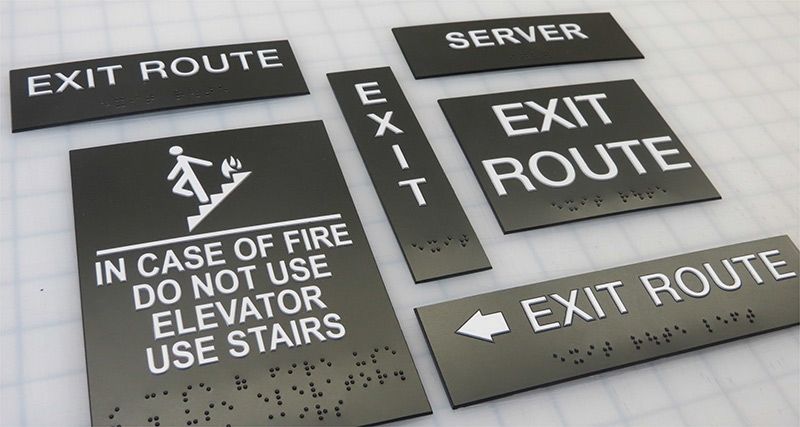Tailoring ADA Signs to Meet Your Particular Requirements
Tailoring ADA Signs to Meet Your Particular Requirements
Blog Article
Exploring the Key Attributes of ADA Indicators for Boosted Availability
In the world of availability, ADA indications act as silent yet effective allies, making sure that areas are comprehensive and accessible for people with impairments. By integrating Braille and responsive components, these indications break barriers for the aesthetically impaired, while high-contrast color pattern and understandable typefaces satisfy diverse aesthetic needs. Additionally, their tactical placement is not arbitrary yet rather a calculated initiative to help with seamless navigating. Past these functions exists a deeper story about the advancement of inclusivity and the continuous dedication to creating fair spaces. What a lot more could these signs indicate in our pursuit of global availability?
Importance of ADA Compliance
Making certain compliance with the Americans with Disabilities Act (ADA) is critical for promoting inclusivity and equivalent access in public spaces and work environments. The ADA, established in 1990, mandates that all public facilities, employers, and transport solutions suit individuals with impairments, guaranteeing they appreciate the same rights and chances as others. Compliance with ADA standards not only satisfies lawful commitments yet also enhances an organization's track record by showing its dedication to variety and inclusivity.
One of the vital facets of ADA conformity is the execution of obtainable signage. ADA signs are designed to make certain that individuals with disabilities can conveniently browse through structures and rooms.
Additionally, sticking to ADA guidelines can mitigate the threat of legal repercussions and possible fines. Organizations that fail to conform with ADA guidelines might face fines or suits, which can be both harmful and financially challenging to their public image. Hence, ADA compliance is essential to cultivating an equitable setting for everyone.
Braille and Tactile Aspects
The incorporation of Braille and responsive components into ADA signs embodies the principles of access and inclusivity. These functions are crucial for individuals that are blind or visually impaired, enabling them to navigate public areas with better independence and self-confidence. Braille, a responsive writing system, is essential in supplying created information in a format that can be quickly regarded through touch. It is usually positioned under the corresponding text on signs to make sure that people can access the information without visual support.
Responsive aspects extend beyond Braille and consist of elevated icons and personalities. These parts are created to be discernible by touch, allowing individuals to determine room numbers, toilets, departures, and other critical areas. The ADA establishes certain guidelines relating to the dimension, spacing, and positioning of these tactile components to maximize readability and ensure uniformity across different atmospheres.

High-Contrast Color Design
High-contrast shade plans play a pivotal role in boosting the presence and readability of ADA signage for people with visual problems. These schemes are crucial as they make the most of the difference in light reflectance between message and background, guaranteeing that signs are conveniently noticeable, even from a distance. The Americans click to investigate with Disabilities Act (ADA) mandates using particular color contrasts to accommodate those with limited vision, making it an important aspect of conformity.
The efficiency of high-contrast colors exists in their capacity to attract attention in various lighting conditions, consisting of poorly lit settings and locations with glow. Typically, dark text on a light history or light text on a dark history is employed to accomplish optimum comparison. Black message on a white or yellow history offers a plain visual difference that assists in fast recognition and understanding.
Legible Fonts and Text Size
When thinking about the layout of ADA signage, the option of understandable typefaces and suitable message dimension can not be overstated. The Americans with Disabilities Act (ADA) mandates that fonts must be not italic and sans-serif, oblique, script, very attractive, or of uncommon kind.
The dimension of the message also plays a crucial role in access. According to ADA guidelines, the minimal text height ought to be 5/8 inch, and it must raise proportionally with watching distance. This is especially vital in public spaces where signage requirements to be reviewed swiftly and precisely. Consistency in message size contributes to a cohesive aesthetic experience, assisting people in navigating settings successfully.
Moreover, spacing between lines and letters is essential to readability. Sufficient spacing prevents personalities from appearing crowded, improving readability. By sticking to these requirements, developers can substantially improve access, guaranteeing that signs serves its designated purpose for all individuals, no matter their visual abilities.
Reliable Placement Approaches
Strategic positioning of ADA signs is necessary for optimizing accessibility and making sure conformity with legal requirements. Effectively positioned signs assist individuals with impairments properly, promoting navigating in public spaces. Secret considerations consist of exposure, elevation, and distance. ADA standards specify that indicators should be mounted at a height between 48 to 60 inches from the ground to ensure they are within the line of sight for both standing and seated individuals. This typical elevation array is essential for inclusivity, enabling wheelchair users and individuals of varying elevations to access information easily.
In addition, indicators need to be put adjacent to the lock side of doors to allow easy identification prior to entrance. Consistency in sign placement throughout a center boosts predictability, minimizing confusion and enhancing overall individual experience.

Final Thought
ADA indicators play a vital function in advertising ease of access by incorporating attributes that deal with the requirements of people with impairments. Integrating Braille and responsive elements guarantees important information is available great site to the aesthetically damaged, while high-contrast shade schemes and clear sans-serif font styles boost presence across various illumination problems. Reliable positioning strategies, such as proper placing elevations and strategic places, additionally promote navigating. These elements collectively foster a comprehensive setting, emphasizing the importance of ADA compliance in ensuring equal gain access to for all.
In the world of access, ADA indicators serve as silent yet powerful allies, making certain that rooms are accessible and inclusive for individuals with impairments. The ADA, enacted in 1990, mandates that all public centers, companies, and transportation solutions fit individuals with impairments, guaranteeing they enjoy the exact same civil liberties and possibilities as others. ADA Signs. ADA indications are designed to make certain that people with impairments can conveniently browse through structures and areas. ADA guidelines specify that indications should be installed at a height in between 48 to 60 inches from the ground to ensure they are within the line of view for both standing and seated individuals.ADA signs play an essential function in advertising availability by integrating attributes that deal with the demands of individuals with handicaps
Report this page